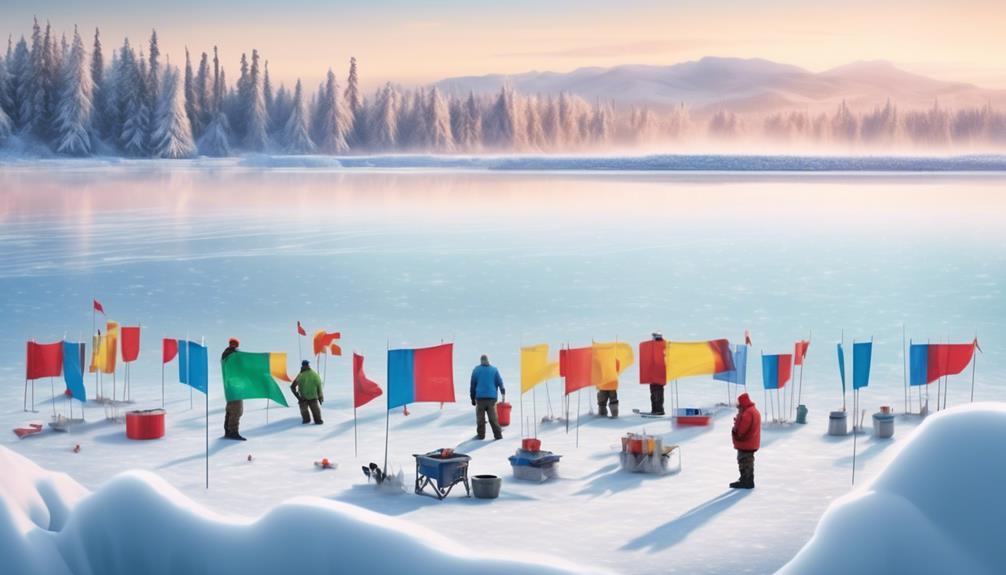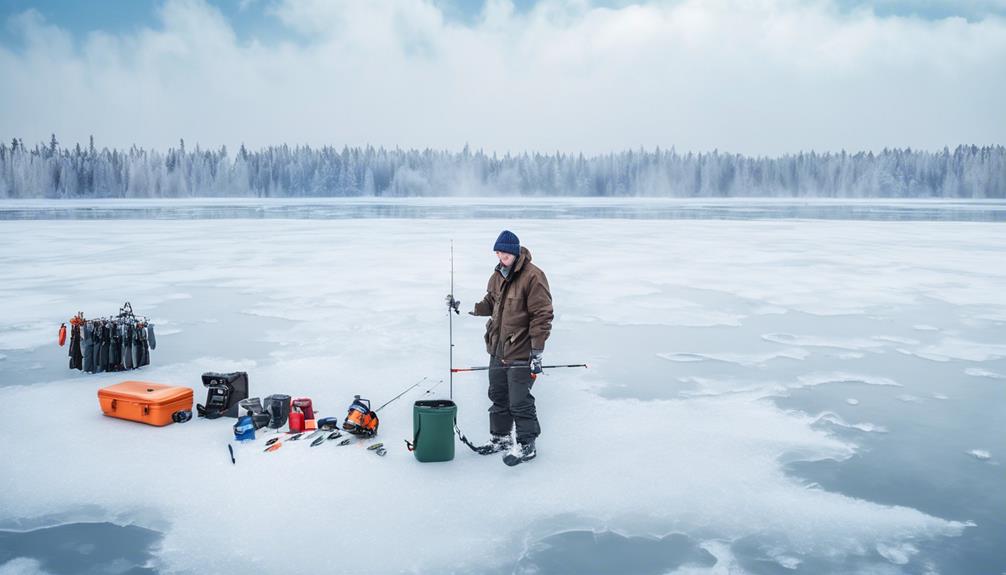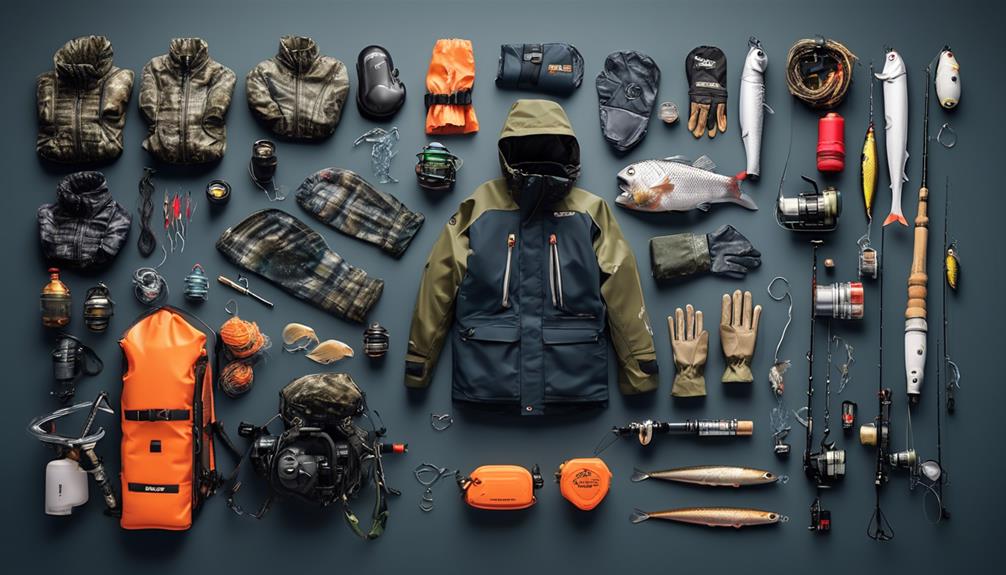When it comes to ice fishing, did you know that in the U.S. alone, over 2 million people participate in this cold-weather sport each year?
Whether you're a seasoned ice angler or just getting started, having the right gear and tackle is essential for a successful and enjoyable outing.
From specialized rods and reels to insulated clothing and shelters, the world of ice fishing offers a unique set of challenges and rewards.
So, if you want to maximize your chances of landing that trophy catch and staying comfortable on the ice, it's crucial to be equipped with the right tools and knowledge.
Ice Fishing Rods
When selecting ice fishing rods, it's crucial to consider the flexibility and sensitivity necessary for detecting bites in cold water conditions. The material of the rod plays a significant role in its performance.
Graphite and fiberglass are the most common materials used for ice fishing rods. Graphite rods are incredibly sensitive, allowing you to feel even the slightest nibble, making them ideal for detecting bites in cold water. On the other hand, fiberglass rods are more durable and less prone to breaking in freezing temperatures. However, they're less sensitive compared to graphite rods. When choosing a rod material, consider your fishing style and the typical conditions you'll be facing.
In addition to material, the length of the ice fishing rod is also crucial. Ice fishing rods are generally shorter than traditional fishing rods, typically ranging from 18 to 36 inches. The shorter length allows for better maneuverability in the confined space of an ice fishing shelter and makes it easier to detect subtle bites. Shorter rods also provide more control when fighting fish through the small ice holes. However, if you're fishing in deeper water or targeting larger fish, a longer rod may be more suitable as it provides better leverage when setting the hook and playing the fish.
Consider these factors when selecting your ice fishing rod to ensure you have the right combination of sensitivity and maneuverability for a successful ice fishing experience.
Ice Fishing Reels
Choosing the right ice fishing reel is essential for smoothly handling and controlling the line while battling fish in icy conditions. When selecting an ice fishing reel, consider the following factors to ensure you have the best tool for the job:
- Line Capacity: A crucial aspect to consider when choosing an ice fishing reel is its line capacity. Having ample line capacity is essential for dealing with larger fish that may take long runs, especially in the unpredictable conditions of ice fishing. Running out of line can lead to missed opportunities, so ensure your reel can accommodate the necessary length and strength of line for the species you're targeting.
- Gear Ratio: The gear ratio of an ice fishing reel determines how many times the spool rotates with each full turn of the handle. A higher gear ratio allows for quicker line retrieval, which can be beneficial when dealing with aggressive or fast-moving fish. On the other hand, a lower gear ratio provides more power, making it easier to reel in larger, heavier fish. Consider the type of fish you're targeting and the specific conditions of your ice fishing location to determine the most suitable gear ratio for your reel.
Ensuring that your ice fishing reel has the appropriate line capacity and gear ratio can greatly improve your ability to handle and control the line, ultimately enhancing your overall ice fishing experience.
Ice Fishing Line
Consider the type of fish you intend to target and the depth of the water when selecting the appropriate ice fishing line. Line visibility and strength are crucial factors to keep in mind when choosing the right line for your ice fishing needs.
When it comes to line visibility, especially in the clear waters commonly found during ice fishing, a low-visibility line is essential. A clear or translucent line that blends in with the surroundings will be less likely to spook the fish. Additionally, using a line with low memory, meaning it stays straight and tangle-free, can further reduce visibility as well as improve your overall fishing experience.
In terms of line strength, it's important to select a line that can withstand the harsh conditions of ice fishing. Thinner lines are often preferred for ice fishing due to their low visibility and reduced water resistance, but it's crucial to ensure that the line still has sufficient strength to handle the potential larger fish that inhabit these icy waters. Look for lines that are specifically designed for cold weather conditions, as these will offer better resistance to freezing and brittleness.
Ice Fishing Lures
To maximize your success in ice fishing, selecting the right lures is essential for attracting and enticing fish in the cold, clear waters. When it comes to ice fishing lures, it's crucial to consider a few key factors to increase your chances of a successful catch.
Here are some essential insights to help you make the most of your ice fishing experience:
- Lure Selection: Choosing the right lure for ice fishing is critical. Opt for small, lightweight lures that mimic the natural prey of the fish you're targeting. Jigging spoons, small jigs, and soft plastic baits are popular choices for ice fishing.
- Color Variety: Experiment with different lure colors to see what the fish are responding to on a particular day. Bright, flashy colors like chartreuse, pink, and orange can be effective in attracting fish in the low light conditions under the ice.
- Depth Control: Controlling the depth at which your lure is presented is essential. Use a depth finder to locate the fish and adjust your lure accordingly. Some lures are designed to sink slowly, allowing you to fish at different depths with ease.
- Attractant and Scent: Consider using lures with added attractants or scents to enhance their appeal. Fish may be more inclined to strike at a lure that emits a natural scent, especially in the cold waters of ice fishing.
Ice Fishing Augers
When it comes to ice fishing augers, ensuring you have the right tool for drilling through the ice is crucial for setting up your fishing spot efficiently. There are two main types of ice fishing augers: manual and power augers.
Manual augers are operated by hand and are generally lighter and quieter, while power augers are motorized, making drilling through thick ice much easier and faster. Whichever type you choose, proper maintenance of your ice auger is essential for its performance and longevity.
Drill maintenance is key to ensuring your ice auger is always ready for action. Before the ice fishing season begins, it's important to inspect the blades for any nicks or dullness and sharpen them if necessary. Keeping the blades sharp will make drilling through the ice smoother and more efficient. Additionally, regularly lubricating the auger's moving parts and keeping it clean from ice buildup will help prevent rust and ensure smooth operation when you're out on the ice.
When preparing your ice hole, it's crucial to have a well-maintained auger for a hassle-free experience. Before drilling, clear any snow or debris from the surface of the ice to prevent damage to the blades. Once the hole is drilled, periodically check the blades for any signs of wear and tear, and make any necessary adjustments or repairs to keep your ice auger in top condition.
Proper maintenance and care of your ice fishing auger won't only make your ice fishing experience more enjoyable but also extend the life of your equipment.
Ice Fishing Shelters
For a comfortable and protected ice fishing experience, having a reliable ice fishing shelter is essential. When choosing a shelter, consider the following factors to ensure an enjoyable and successful ice fishing trip:
- Shelter Insulation: The insulation of your ice fishing shelter is crucial for maintaining a comfortable interior temperature, especially during harsh winter conditions. Look for shelters with thick, insulated walls and floors to trap heat and keep you warm while out on the ice. This will help you stay focused on fishing rather than battling the cold.
- Shelter Portability: Opt for a shelter that's easy to transport and set up, allowing you to quickly move to different fishing spots as needed. A portable shelter will provide flexibility and convenience, enabling you to adapt to changing weather and fishing conditions without hassle. This feature ensures that you can make the most of your time on the ice.
- Durability: Choose a shelter made from sturdy materials that can withstand the rigors of ice fishing. A durable shelter will offer protection from the elements and provide long-lasting reliability, allowing you to enjoy multiple seasons of ice fishing without worrying about constant repairs or replacements.
- Size and Layout: Consider the size and layout of the shelter to ensure it fits your specific needs. Whether you prefer a compact solo shelter or a larger one for group outings, selecting the right size and layout will enhance your overall comfort and fishing experience.
Ice Fishing Tip-Ups

Considering the importance of reliable gear for a successful ice fishing trip, understanding the functionality of ice fishing tip-ups plays a crucial role in optimizing your fishing experience. Tip-ups are invaluable tools for ice anglers, allowing you to fish multiple holes simultaneously without having to constantly tend to each one.
To maximize your success with tip-ups, it's essential to master effective tip-up techniques and prioritize tip-up maintenance.
When it comes to tip-up techniques, one of the most important aspects is setting the depth of your bait. Different fish species prefer different depths, so it's crucial to adjust the depth of your bait accordingly. Additionally, using live bait or lures that mimic the natural movement of prey can significantly increase your chances of attracting fish to your tip-up. It's also important to regularly check your tip-ups for any signs of activity, as this allows you to quickly react and set the hook when a fish takes the bait.
In terms of tip-up maintenance, ensuring that your tip-ups are in optimal working condition is vital for a successful ice fishing trip. This includes regularly checking the line for any fraying or damage, as well as lubricating moving parts to prevent freezing in cold temperatures. Proper storage and regular cleaning after each use will help extend the lifespan of your tip-ups, ensuring they remain reliable when you need them most.
Ice Fishing Clothing
To ensure your comfort and safety while ice fishing, selecting appropriate clothing is essential for withstanding the harsh winter conditions. When it comes to ice fishing clothing, layering techniques are crucial for maintaining warmth and regulating body temperature.
Start with a moisture-wicking base layer to keep sweat away from your skin, followed by an insulating layer to trap heat, and finally, an outer layer to shield against wind and moisture. This layering system allows you to add or remove clothing as needed, keeping you comfortable throughout your fishing expedition.
Here are some essential items for your ice fishing clothing arsenal:
- Moisture-Wicking Base Layer: A quality base layer is designed to keep moisture away from your skin, preventing you from getting cold and damp during your fishing trip.
- Insulating Mid Layer: Opt for a thick, insulating layer to retain body heat, such as a fleece or down jacket.
- Windproof and Waterproof Outer Layer: Invest in a durable, windproof, and waterproof outer shell to protect you from the elements.
- Insulated Footwear: Keep your feet warm and dry with insulated, waterproof boots designed for sub-zero temperatures.
Frequently Asked Questions
How Do I Choose the Best Location for Ice Fishing?
When choosing the best location for ice fishing, consider ice thickness and weather conditions. Check for at least 4 inches of clear ice for safety. Look for areas with less snow cover and avoid slushy or unstable ice.
What Safety Precautions Should I Take When Ice Fishing?
When ice fishing, always check ice thickness before venturing out. Bring an emergency kit and never go alone, use the buddy system. Dress warmly to prevent hypothermia. Always prioritize safety when enjoying this winter activity.
Can I Use Regular Fishing Gear for Ice Fishing?
Yes, you can use regular fishing gear for ice fishing, but specialized equipment options are available for better results. Technique differences are important to note, such as using shorter rods and lighter lines to accommodate the unique conditions.
What Are Some Common Mistakes to Avoid When Ice Fishing?
When ice fishing, avoid common mistakes by prioritizing equipment maintenance and safety. Ensure your gear is in good condition and always check the ice thickness for safety. Use proper bait and technique for a successful outing.
Are There Any Specific Regulations or Restrictions for Ice Fishing in My Area?
Before hitting the ice, check local regulations and restrictions. Ice fishing regulations can vary by area, so it's important to know the rules before you go. Make sure to stay informed to avoid any issues.
Conclusion
Now that you have all the essential ice fishing gear and tackle insights, you're ready to hit the ice and reel in some big catches.
Remember to stay warm and safe out there, and have fun exploring this unique and exciting winter sport.
Happy fishing!



